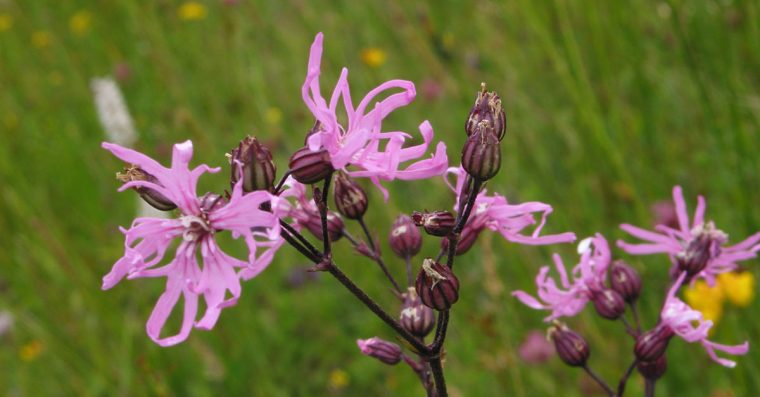Printed from: https://finalhbks.asgoodasready.com/wildflowers/ragged-robin/
Scientific name: Lychnis flos-cuculi
Family: Caryophyllaceae (Pink)
Ragged-Robin is a perennial plant of damp places. It is typical of damp meadows and woodland, marshes and ditches. It is a common plant across the UK, however, due to drainage and agricultural improvement of wet grassland, local populations have declined over the past decades.
The first part of its scientific name ‘Lychnis‘ comes from the greek word ‘lukhnis‘, which means lamp. This alludes to the bright pink flowers, which stand out in the late spring landscape. In the United States, the Ragged-Robin is also called Cuckoo Flower, which matches the translation of ‘flos-cuculi‘ – but not to be mistaken by the wildflower that we know of as Cuckooflower.
Its typical common name, Ragged-Robin, comes from the bright pink flowers with ragged petals, and the fact that both plant and bird stand out brightly at the start of summer.
The basal leaves are stalked and oblong, whereas the stem leaves are narrow, stalkless and borne in opposite pairs. Ragged-Robin flowers in early summer from May to July. The pink flowers are made up of five petals, each of which is divided into four linear lobes. It is a favoured larval food plant of moths like the campion (Sideridis rivularis) and the lychnis (Hadena bicruris).
As a clever mechanism against attack, the stalk of Ragged-Robin is covered with tiny downward-pointing hairs that prevent small insects such as ants climbing up the stalk and attacking the flower.
One specific feature of Ragged-Robin is that the root contains saponins. This soap substitute that can be used for washing clothes, hair etc. and can be extracted by boiling the roots in water.
Propagation
From seed
Sow seed in late summer or autumn in a cold frame. The seeds do not germinate well in spring. Prick the seedlings out into individual pots, when they are large enough to handle. Plant the seedlings out the following summer. The seed can also be sown in situ in early autumn. Ragged-Robin is a prolific producer of seed.
By division
Because Ragged-Robin produces so much viable seed, often seeds will be dispersed close to the parent plant where seedlings will grow. Ragged-Robin is also easily propagated vegetatively as small plants extend from the basal rosette. If space is limited the plantlets will grow on top of each other producing a mound of viable plants. Divide the plants in spring or autumn. Larger clumps/or plantlets can be replanted direct into their permanent positions. Carefully pot up smaller plants and seedlings that grow around the base of the parent plant and grow them on in a cold frame until they are rooting well. Plant them out in the spring.

